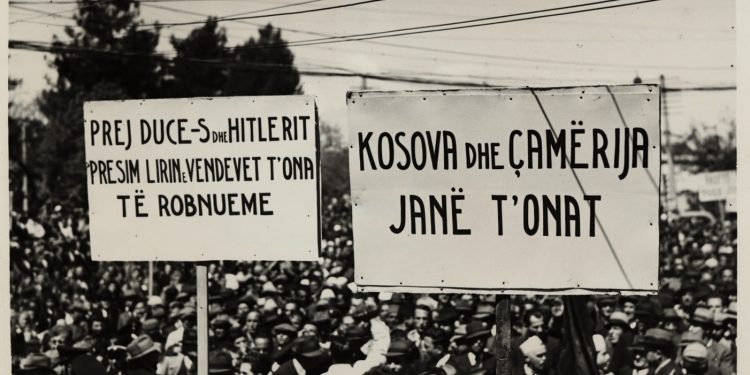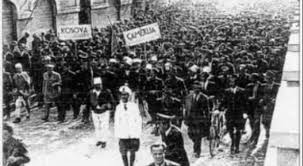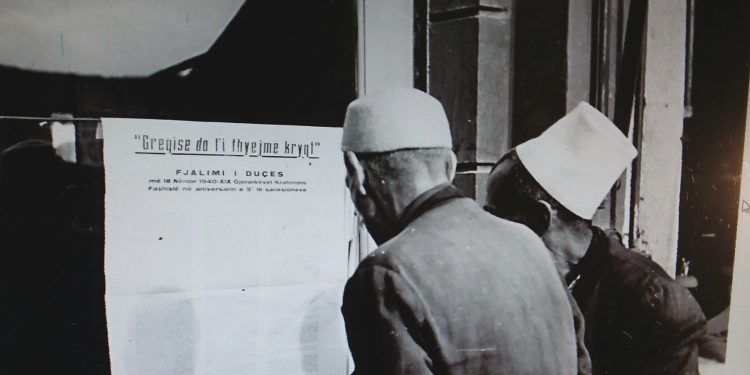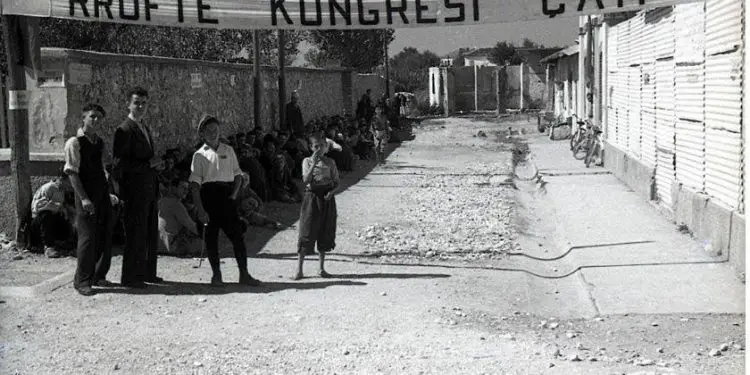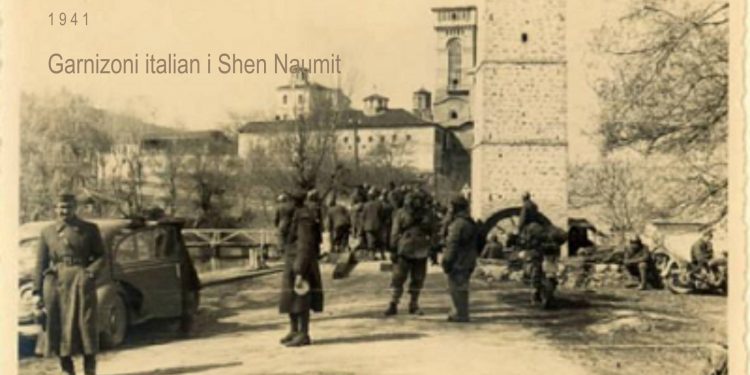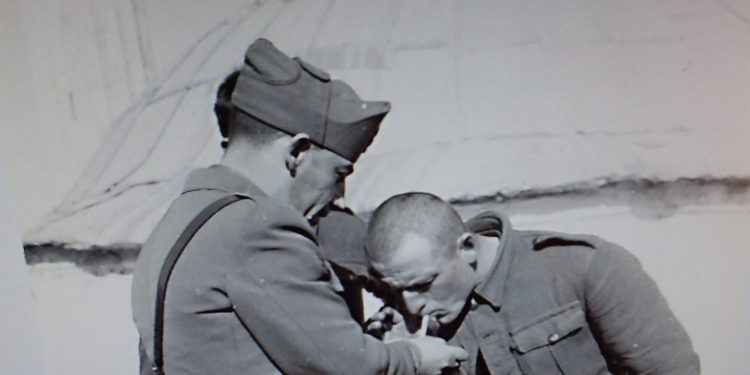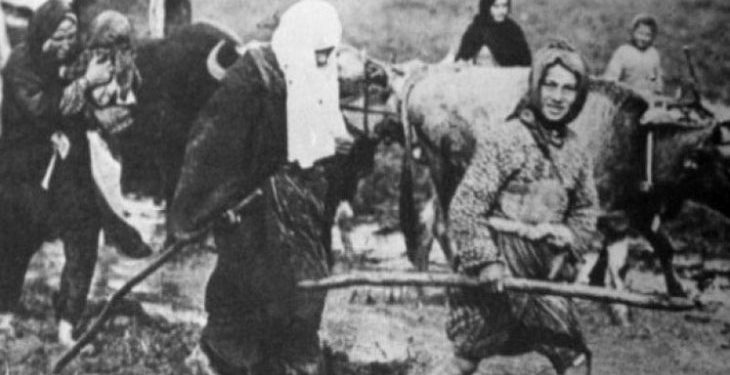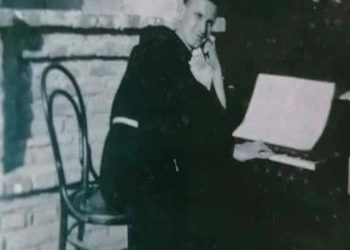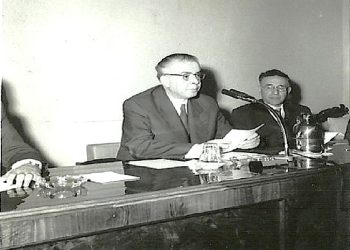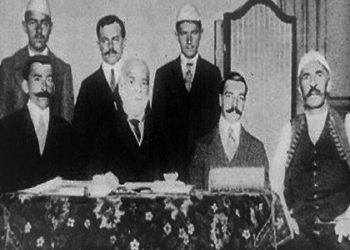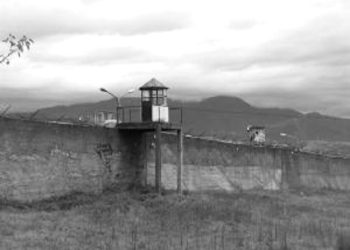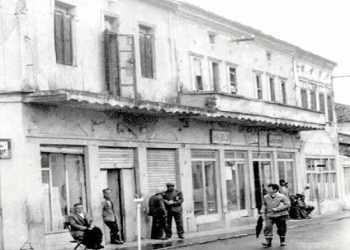Memorie.al/ publishes an unknown study on Chameria published in the magazine “Vatra Shqiptare” published by Radio-Tirana in 1941, which is based on events, facts and historical documents, which shed light on the massacres and unprecedented Greek genocide against the autochthonous Cham Albanian population, which has its origins since 1780 when it was all of the Orthodox faith …
Following the publication of a series of articles of historical character, Memorie.al will continue to publish various articles related to Chameria and its painful history under the occupation and oppression of the Greeks, which has continued systematically in these three -the last four centuries. In today’s issue we have selected for publication, a long research article based on events, facts and historical documents, which we have taken from the magazine “Vatra Shqiptare”, published by Radio Tirana in 1941, during the Italian occupation. In this study article (where the author did not put his name), although written at a time when Italy was at war with Greece, the whole history of Chameria’s relations with Greece is treated with a scientific objectivity, starting from 1870, when that population was all of the Orthodox faith, until 1941, when the article in question was published, which we are publishing with some abbreviations (for country reasons), and without making any changes in linguistic terms.
Mother Albanian lands
Notes on Chameria, on its history and on the geographical environment
Chameria since ancient times has always been Albanian and in ancient history the Chams are called titans, while the Ghegs are called giants (without Odhisena). All Greek writers called all foreigners who spoke foreign languages barbarians as if they were barbarians. The Chams have always been Christians until the time of Ali Pasha Tepelena, but even in the period of Muslimization there has always been a full cooperation between Christians and Muslims for the protection of national interests and for the fight against the Greeks. In 1913, when deserted Chameria was forced to accept Greek rule, I imposed the following conditions on the occupying armies:
- Only the regular army had the right to occupy the country.
- Respect for the honor and customs of the country.
- Surrender of weapons voluntarily. However, unfortunately, when the Greeks entered Chameria, they started to make the living of the population unbearable, trying to denationalize it. A first theft to the detriment of Albanians was presented by a full 25,000 head of cattle in addition to money and valuables; the most important mayors either escaped by fleeing mountain by mountain or forest by forest or were slaughtered. It is not possible to make a list of victims, and yet if this were to be done it would not diminish the significance of the terrible tragedy, for the Greeks were treated as barbarians and as people without religion.
Greek massacres against the Chams and the Greek-Turkish treaty
In April 1913, by order of Colonel Ebitis, Subbi bej Dino, Pronjo from Paramythia and Alush Gjyzeli from Margellici in Nimize were arrested and barbarically arrested, arrests and murders were made without charge, without trial, but just because they were Albanians. Shortly afterwards, 72 people were massacred in a single well who had been summoned to appear before authorities in Paramithi. Among them are Mehmet bey Kasiqani, Resul Çene, Sadhua Dine, Adem Bedleni, Fejzo Nazisi, Jusuf Bezhani, Malo Kasëmi, Bego Kasëmi and Refik Tahiri. The martyrdom of the Cham people culminated in March 1917, when 400 Albanian Orthodox families, of course, were taken to their feet with guns in their hands, cut off communications with Ioannina and banned all relations with the Greek Government, declaring themselves independent, which this lasted until August of that year, viz. until the Italian powers conquered Ioannina with all of Epirus. Attacks against the Greeks then became more frequent and fiercer. But of course, the numerical and ay proportion of the defensive and offensive means toasted, and so the Chams, defeated but undefeated, were compelled to suffice with gang fighting. At the site of Nista in 1915, a company of Greek soldiers, who had gone there to disarm the people, under the command of Captain Chiamankakos, as he began to use torture and insults, was disarmed with disgrace from the population and was subjected to general ridicule. Meanwhile, the Albanians of Chameria, who were in foreign countries, started to kill the European capitals and especially London, with protests for the protection of their nationality and the human rights violated by the Greeks. Following the Greek-Turkish treaty on population exchange, 10,000 Chams were forcibly sent to Turkey, but this vicious exchange was forced to be stopped after a protest by the Tirana government, especially protected by Italy. It was at that time in 1925 that the installation in Albania of 1500 people who fled after those Greek persecutions took place.
Geographical location and characteristic clothing of Chameria
The part of Chameria that is under Greek tyranny is bordered on the North by the mountains of Nemercka, Murat, Struga, Tsamanta, Konispol and descends East by the Prefecture of Konica and Ioannina; to the South with the N / Prefecture of Arta and goes as far as the bay of Preveza, opposite the linguist of Aktios; to the West by the Ionian Sea. The country is mountainous and is a continuation of the politically and ethnically Albanian mountains and the Tsamantas. An important river is that of Kalama that, passing through Kamenica and Filat; constitutes the area of these two areas and into it the streams and streams of central Chameria. In winter this river is not passable (guadabile); river Llur of the mountains Olizika flows in Prevesan, passing through the middle Chameria along the plains of Filipiadha and Prevazan, the plain of Filipiadha is wide because it has a mass of 30×18 km., that of Llahe Suli has a mass of more than 18 km. Road communications are as follows: Prevezan-Filipiadhë km. 43, Philippines-Ioannina km. 62, Philippines-Golden km. 14. The roads Kumenica-Janina, Preveza-Paramithi, Paramithi-Menina, Menin-Filat, Filat-Sajadhë are being repaired. The Chams of the Illyrian race, i.e. simple blood Albanians are with high and beautiful appearance, wear white wool suits, high and white shirts in the form of religion and sneakers, the classic mountain footwear. Women wear long white clothes and shirts with long white socks and embroidered on the variegated part with all kinds of flowers; on the head tie a colored handkerchief. But men’s clothing is being lost out of nowhere, because the so-called “western alla franca” clothes are cheaper. Until 1780 the population of Chameria was the whole follower of the Greek Orthodox religion, Islamism began later, and spread especially, as we said, in the time of Ali Pasha. The tragedy of the people of Parga is well known, who emigrated by emptying the centuries-old ancestral hearths, so as not to give up the religion of Christ, and spread to the 7 islands that at that time were under the rule of France (part of it went and in Corfu).
The bravery of the women of Sul from the inhuman persecutions of Greece
It is known and admired everywhere the heroic beauty of the women of Sul, who in bridal dress, so as not to fall into the hands of the Turks and not to give up the Christian religion, singing patriotic songs, were given to death by jumping into the abyss of their village. The introduction of Greek propaganda began in 1880 through the Greek Church in Istanbul, the center of pan-Hellenism, and spread with systems known after 1913. According to 1933-1934 statistics, 205 primary schools were opened with 14,050 students and 7 schools. high school with 795 students. With these means, with systematic propaganda and inhuman persecutions, the Greeks managed to infiltrate the Greek language, to make it popular, but not to make them forget the language of their ancestors, i.e. Albanian.
Statistics of the Cham population by prefectures
With all these, the Greek villages are few and consist of peasants brought as owls to their lands by the Albanian beys, according to needs; these villagers have become landowners today after the application of the Agrarian Reform in connection with the persecution of the Greek authorities, stubborn and ruthless in the act of denationalization of Chameria. There are no villages with mixed populations, but there are places with mixed populations, Muslim and Christian, all of the Albanian Nation. N / Prefecture of Filati has 79 villages with 32,024 inhabitants, among which 3,500 use Albanian and Greek languages (bilingual); N / Prefecture of Paramythia has 47 villages with 15.8486 inhabitants, among which 5000 who speak both languages; N / Pogon Prefecture has 33 villages with 13,888 inhabitants, among which 6,200 are Greek-speakers, but there are also these Albanians who were forcibly Greekized. N / Prefecture of Prevezar has 46 villages with 21,160 inhabitants, of which 10,000 are Greek-speakers, also those of Albanian origin; N / Prefecture of Filipiadha has 31 villages with a population of 15,530 inhabitants, of which 4000 are Greek-speakers as the first. There is a total of 279 villages with 112,619 inhabitants, of which only 20,200 are Greek-speakers, but of Albanian origin. However, according to Greek statistics of 1937, 92,419 inhabitants are Albanians one thousand per thousand, while 8,500 are speakers of both languages. In these inhabitants 33,000 are Muslim Albanians.
The natural resources of Chameria
Chameria as we said is mountainous and rich in olive trees that give very good olive products to eat and a very good oil; produces very good tobacco and animals of a breed that is not to be despised, produces wheat and corn. Vines are planted that produce very good grapes. Before 1913 the Chams lived on their agricultural products and also exported to Corfu. The coasts of Chameria, on which the mountain rocks lie, constitute important valleys such as Preveza, Kamenica, Murti, Parga, Sajadha, between which Preveza and Kumencia lead, from which the Corfu Canal and the Adriatic entrance dominate. I appreciate these geniuses of Napoleon I and the English plunderers, who at the beginning of the last century conquered those sea shores. The city of Ioannina and its districts are part of Chameria for strategic and demographic reasons. Many authors have written about Chameria, we are showing them the least known. Interesting are the studies of Valentino Chirol, who describes a trip he made to Epirus in 1880 and in which he boasts the Albanian patriotism of the Chams; Henry Holland, in his book entitled “Travels in the Ionian Islands, Albania, Thessaly, Macedonia”, Byron, etc., are not to be forgotten Odiseja XXX-315-385; Thuqidhidi, Greek world geography, volume B. 1937; The Great Greek Encyclopedia in the Chapters of Epirus-Ioannina, where no matter how much it has tried to falsify the truth, it seems clear to one who studies with impartiality and justice.
Notes on Epirus
Although there are differences of opinion of ancient and modern authors, Epirus or Southern Albania, is a province in the south-west of the Balkans that has the shape of a three-card whose base is composed of the river Shkumbin and the peak is located in Preveza or in Nicopolis to the South. This province constitutes a geographical, strategic, economic, and ethnic unit. Its appearance is clearly defined by natural borders and completely separated from Greece. On the other hand, all the authors who have studied ancient Greece have said the same thing, that the borders of Greece do not cross either Thessaly to the east or Arkania to the west. Epirus therefore remains outside the historical borders of Greece. Indeed, Epirus did not take part in the Trojan War, nor in the Greek war against the Persians, nor in the Peloponnesian war which had a sole Greek character. The Epiriots in turn interfered in Greek affairs, only when they had called, as paid soldiers, from the Greek colonies of Sicily and southern Italy. As we said above. Epirus is always a complementary part of Albanian and the only difference with northern Albanian is found in the dialect, Tosk Albanian, which is slightly different from the northern dialect called Gegnishtja. On the other hand, the two dialects are understood both by the population that speaks them respectively. This weather region, like sod, is defined from the east by the great range of the Pindi mountains, to the west and south-west by the Ionian Sea, to the north by the Shkumbin River, to the south by the Bay of Preveza; it was divided into sectors that each had a special name, the names that are these, start from the north and go from the south:
- Tanluncja (province of Myzeqe).
- Antinatania (between Vjosa and Osum)
- Desarceja (province of Korça)
- Kaonja (Gjirokastra province)
- Thesprocja (Today’s Chameria)
- Molossia (actually Mulësija, province of Ioannina.
- Atmaja (province of Pindi)
Of these seven, the first four sectors were assigned to Albania by the Assemblies of London and Florence, while the other three, i.e. Chameria, the Pindi cluster, and the intermediate sector of Ioannina, were unjustly annexed to Greece;
Etymology of places
Yet the allogeneic character of these three sectors vis-rejt-vis mainland Greece remains inviolable; on the other hand their older names have an etymologically purely Illyrian look; Thesporot or bag full, wanted to mark the fruitful place; Molossi or Mulësi wants to say mountain place, in comparison with the coast; Atamania Don told me old place. Indeed, the Greek authors when talking about Thesprots or Moles, say that they are barbarians, i.e. foreigners against the Greeks, after the latter had taken to distinguish the Greeks from other nations, this formula: “After mi ellin varvatos”, or: who is not elen, is a barbarian. In no historical period has either southern Epirus or northern Epirus been occupied by the Greeks. The most famous dynasty of southern Epirus here is that of the Man called “Lacide”; tye hjekun of the Greek meme, remains the proper name “Laç”, which is a dance Illyrian name and which is often used today. The man, in the time of his childhood when he pursued and was expelled from his opponents, found refuge in the north of the Illyrian King of Tanlancia, until the reconstruction of his dynasty. Southern Epirus climbed Greece, weather and in Byzantine times has had the influence of Greek culture only because of the proximity and effect of the Christianity of the eastern Church of Constantinople. But this kind of influence is universal for all Christian countries of origin. And this fact does not create a title in favor of Greek domination, because in ancient times the Greeks, as a people, naval, merchant and colonizer, created everything in the bacillus (basin, watershed, here understands the Mediterranean Sea, our note), master. Tue includes its great genders which are the Adriatic and the Black Sea, colonies that exercised a kind of cultural influence over the peoples of the underworld, so that the Greek language is the cultural language of all the peoples of the native bacin, just as Latin is the cultural language of Western Europe in the Middle Ages (Middle Ages), and as Arabic here in the Muslim world. After the former Ottoman Empire here a theocratic Empire dividing peoples subject to its domination into Muslim and non-Muslim, considered all Orthodox Christians as belonging to a single race (race) and placed them under the influence of the Greek patriarchate of Constantinople to whom, on the day after the conquest of Constantinople, he bestowed great privileges, for the sake of which the patriarchate had a dominating influence in favor of Hellenism.
The Greek Revolution of 1821, the work of the Albanians
For this reason, the Greek revolution of 1821 for independence muer as words commanded “for faith and for the Homeland”: This revolution did not use the words “Greek” or “Hellenic”, because most of the fighters,’s the best, were Albanians, kuzovëllahët etj. But from that time on, as a follower of the great revolution of 1789, the notion of nationality first arose in the pre-eminence and in the middle of the nineteenth century among the Christian peoples of the east. However, modern Greece does not want to understand this great historical shift. It has mixed it with orthodox resistance and Hellenism, and for this reason the Balkan east is here a battlefield and bloody battles between the national spirit of the Balkan peoples on the one hand and Hellenism on the other. The struggle of the Bulgarians against the patriarchate of Constantinople is no other than the struggle of the Bulgarian nation against the artificial Hellenism maintained by the spiritual force of the patriarchate and by the secular wing of the Ottoman Empire that important an outdated institution. With the help of the Russian panslavs, the Bulgarians brought out their esarkat and their schools in the Bulgarian language. If the war gained a pound in favor of the Bulgarians, for the northern Balkans the same war continues fiercer in Eastern Rumelia and especially in Macedonia. After the Bulgarians came the order of the Kuzvlahs and the Orthodox Albanians themselves.
The efforts of the Greeks to assimilate the Chams
And now let us see how this war took place between the Albanians on the one hand and the Hellenes on the other. The Albanian and Vlach national movement can be said to have started simultaneously after the Berlin Treaty. Art. 24, protocol No. 13 of this treaty spoke of a redress of the borders between Greece and Turkey and the second paragraph of the same treaty explained that the east of Thessaly and in the west, i.e. in Epirus, the southern part, up to the river Kalamas would have been left to Greece; with this concession Chameria and the brothers of the Pindi collection would clothe Greece. After the publication of this provision of the treaty, the Albanian movement of Ioannina and Chameria and the Vlach movement of the province of Thessaly and Epirus began to appear through the meetings of the parish and energetic protests near the great powers. The brothers possessed not only the Ionian and Adriatic slopes in the province of Epirus but also the slope of the Aegean of Pindi. Greece soon put up a resistance against the Albanians of Ioannina and Chameria. Thus, the large pan-Hellenic committee called “Ethniki Eteria” organized armed detachments and sent them to Epirus and Thessaly. The Central Committee of Ioannina decided to extinguish three of the Albanian parishioners (leaders) residing in Ioannina who had incited the national movement against the annexation of this country to Greece; three of the parishioners are Abdyl Bej Frashëri, Ragip Bej Frashëri, Myslym, Bej Frashëri. Afterwards, he was the first to head north in order to organize the movement and spread a spirit of freedom and nationality. part of Konica) and the other in Kranja, (part of Mocovo). The instigator of the Vlach movement, Apostolo-Margariti, took the necessary measures to protect himself from the secret attacks of the gangs. However, the Albanian movement in Epirus had taken over everything that included the vilayet of Ioannina, in a way that could be related to the north movement that was based in Prizren. Greece, in order to create a work to be done in southern Epirus, organized in 1879 a group of very strong detachments, which consisted of soldiers who had turned into soldiers and were about to land suddenly in Saranda. But after the Albanian movement was already more fully awake, the war took up arms of the two opposing sides and took place once after landing in Saranda and in the village of Lekura near Saranda. This savage war took pound with the complete defeat of the Greeks.
The murder of the Albanian Spiro Kosturi and the expulsion of the Chams in Turkey
After the year 1903, these assassinations were numerous, both against the Orthodox Albanians and against the brothers. These sacrifices could be presented in hundreds; among others Spiro Kosturi, an Orthodox Albanian, was killed here by the Greek committee of Thessaloniki in the banning of that city in 1906. to fall. This spiritual and criminal salvage system lasted until the Balkan elevator of 1912-13. When the Greek army invaded southern and northern Epirus, the first salvage of the war turned into systematic carnage not individual but in the hundreds. As soon as the Greek army entered Chameria, it selected 72 people from the Albanian leadership of Chameria and allegedly sent them to Ioannina, halfway through, where they were massacred by Greek official gendarmes, in order to increase the situation. Due to these tragic events, the Albanian delegates protested in front of the Assembly of London, which was held here after the Balkan wars of 1912-13. The Albanian delegation to receive such tragic cases presented its complaints to Mr. Venizelos, Minister of Greece, who recognized the cruelty of the event and promised that he would not prove it to them in the future. Indeed, these tragic events, if near (ceased to happen), were repeatedly confirmed by the peculiarities of the squads and gendarmes, why the Cubans, in order to keep me alive, were paid by the Greek authorities and they are named as field guards among Albanian villages. The Greek salvage was intended to seduce the Muslim Albanians and to coerce the Albanian Orthodox through the Church and the School to officially deny that the mother tongue was spoken. The strongest weapon of the Greek authorities against the Albanians is the confiscation of large properties carried out by the State and the occupation of the individual lands of the Albanians by the Greeks of the districts under the protection and at the disposal of the authorities. All these measures are so strict that a large part of the Muslim Albanians who remained under Greek rule, so much so that the issue of forced exchange of populations between Greece and Turkey, were declared Turkish citizens to escape from a situation that can not to be patient. Thus, the Muslim Albanians of Konica, Ioannina, Preveza, Filip Jada and Parga, left for Turkey in 1924-25. Despite these tragic events and despite the great reduction of the Albanian and Vlach population, as the course of the above-mentioned salvage, the Country of the East, i.e. Malcija of Pindi and West, i.e. Chameria still preserves the Albanian and Vlach character. The Greek and Greekizing element remained only in Ioannina and among the districts included between the Albanian Chameria and the high mountain of Pindi inhabited by Vlachs.
“Chameria is Albanian and we will not leave it to Greece”
Statement by the British Foreign Secretary at the London House of Commons
In the long study article published in the magazine “Vatra Shqiptare” published by Radio Tirana in 1941, its author (has not given a name), dwells extensively on the events of 1875-1881, when the Albanian National Movement forced its forces great to take seriously the problem of Chameria. In this regard, the article in question, among other things, reads: and prevented the Commission from arriving at the site of the new border which had been razed. The Ottoman Commissar, Gazi Muhtar Pasha, we saw the great difficulties that were present in the city of Preveza, he and his colleagues of the 6 Great Powers climbed over the Ottoman crossroads that had dropped anchors in the bay of Preveza. The Albanian national movement continued from 1875 to 1881 and vigorously opposed the unification of southern Epirus with Greece. The event therefore became an international diplomatic affair that ended with Greece leaving only Thessaly, leaving southern Epirus to Albanian. How long did the screening that took place in the House of Commons in London, the British Minister of Foreign Affairs, after asking about the Greek-Albanian border, stated that the land in question had an “Albanian” character, and could not leave it, therefore Greece. In other words, the Albanian character of southern Epirus – adjacent to Greece in pursuit of the Balkan war of 1912-1913 – is recognized by an international decision. After this time Greece opened another front of racial warfare against the Albanians and the brothers who acted entirely within the bounds of the law for the guard and salvation of their nation. For him during this war of secret gangs, now open, Greece used four means. A) the influence of the Church through the Bishops and the clergy. B) the propaganda of its consuls. C) tricked the Ottoman authorities into thinking that the Albanian national movement was an uprising against the Empire. D) you killed, without looking closely, Albanian personalities with the help of armed squads, paid and organized by Greece and generally ruled by its officers. The action of the Greek church was guarded by the Albanian Orthodox and by chance, they were sentenced to a kind of civil prison and were not given the baptism, the blessing, the communion, the faith ceremonies of the funeral offerings. When this spiritual weapon was insufficient, the Greek Bishop sued the Ottoman authorities as revolutionaries against the sovereignty of the Empire. If, fortunately, a lawsuit was filed against the intelligence and intelligence of the Government, the armed groups would be charged without any other means to extinguish the sacrifices “. / Memorie.al




